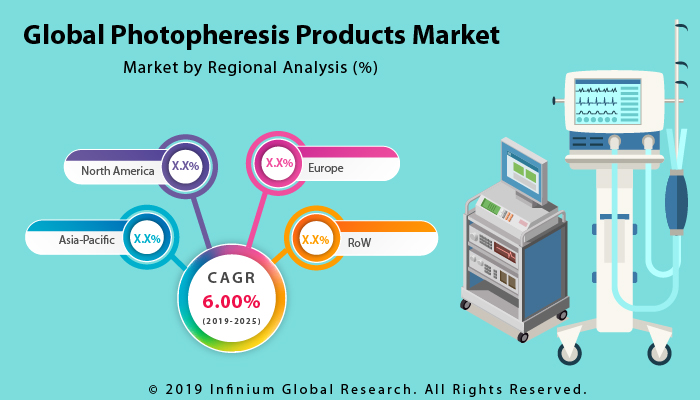Photopheresis Products Market (Product Type - Closed System, and Open System; Therapeutic Area - Graft Versus Host Diseases, Cutaneous T-cell Lymphoma, Solid Organ Transplant Rejections, and Autoimmune Diseases; End User - Specialty Clinics, and Hospitals): Global Industry Analysis, Trends, Size, Share and Forecasts to 2025
A recent report published by Infinium Global Research on
photopheresis products market provides an in-depth analysis of segments and
sub-segments in the global as well as regional photopheresis products market.
The study also highlights the impact of drivers, restraints, and macro
indicators on the global and regional photopheresis products market over the
short term as well as long term. The report is a comprehensive presentation of
trends, forecast and dollar values of global photopheresis products market.
According to the report, the global photopheresis products market is projected
to grow at a CAGR of 6.00% over the forecast period of 2019-2025.
Market Insight
In recent years photopheresis products have emerged as the most
efficient and effective treatment method for various autoimmune diseases, solid
organ transplant rejections, host disease versus chronic graft, and T-cell
lymphoma. In 1988, FDA approves the therapy, which is being mostly considered
as the first step of treatment for various diseases due to benefits including
better safety, efficacy, and low rate of side effects compared to other
treatments. Rising demand essentiality of blood-derived products is anticipated
to propel the photopheresis products market in the near future.
Global photopheresis products market is primarily driven by the
increasing number of organ transplant cases, rising prevalence of autoimmune
diseases. Moreover, the rising increasing infrastructure in health care
industry, the growing geriatric population, and new and advanced technologies
is expected to fuel the market growth in the near future. However, less
expenditure on healthcare by under developing countries and less healthcare
infrastructure in the less developed region is expected to hinder the demand
for the global photopheresis products market. Nonetheless, Increasing private
health care insurance, rising government reimbursement policies and increasing
awareness among people is anticipated to create a new opportunity for the
global photopheresis products market.
On the basis of region, the global photopheresis products market
is bifurcated into North America, Asia Pacific, Europe, Latin America, and the
Middle East and Africa. North America held the largest revenue share for the
global photopheresis products market in 2018 owing to the increasing awareness
among people, proper and well-structured reimbursement policies from the U.S.
government, huge count of autoimmune disease patients in the region. Asia
Pacific is expected to be the fastest-growing region during the forecast period
owing to the rising acceptance of new photopheresis device, faster regulatory
approvals, and advanced research. North America is followed by Europe as the
rapid adaption rate of new technology and well-spread healthcare infrastructure
in the region.

Segment Covered
The report on global photopheresis products market covers segments
such as product type, therapeutic area, and end-user. On the basis of product
type, the sub-markets include closed system, and open system. On the basis of
therapeutic area, the sub-markets include graft versus host diseases, cutaneous
T-cell lymphoma, solid organ transplant rejections, and autoimmune diseases. On
the basis of end-user, the sub-markets include specialty clinics, and
hospitals.
Companies Profiled:
The report provides profiles of the companies in the market such
as Med Tech Solutions GmbH, Mallinckrodt Pharmaceuticals, Haemonetics
Corporation, Macopharma, Fresenius Kabi AG, Terumo Corporation, and
Mallinckrodt Pharmaceuticals.
Report Highlights:
The report provides deep insights into the demand forecasts, market trends, and micro and macro indicators. In addition, this report provides insights into the factors that are driving and restraining the growth in this market. Moreover, The IGR-Growth Matrix analysis given in the report brings an insight into the investment areas that existing or new market players can consider. The report provides insights into the market using analytical tools such as Porter's five forces analysis and DRO analysis of photopheresis products market. Moreover, the study highlights current market trends and provides forecast from 2019-2025. We also have highlighted future trends in the market that will affect the demand during the forecast period. Moreover, the competitive analysis given in each regional market brings an insight into the market share of the leading players.
